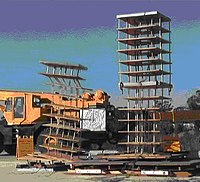
Photo from wikipedia
For the seismic design and seismic safety checks of large storage dams, dynamic analyses have to be carried in the time domain, as inelastic deformations have to be expected under… Click to show full abstract
For the seismic design and seismic safety checks of large storage dams, dynamic analyses have to be carried in the time domain, as inelastic deformations have to be expected under the safety evaluation earthquake ground motion. As input for such analyses acceleration time histories are needed. The characteristics of these time histories are discussed. They may include features such as spectrum matching of recorded or artificial acceleration time histories, aftershocks, directivity effects, near-fault effects, extended duration of strong ground shaking, number of earthquakes, and stochastic independence of earthquake components as listed in the new guideline on the Selection of Seismic Parameters of Large Dams of the International Commission on Large Dams. These acceleration time histories used for dam design are models of earthquake ground motions but have hardly anything in common with real earthquake acceleration time histories, but using such records, the dam engineer can provide a safe design, which is the main objective of the design of any structure.
Journal Title: International Journal of Civil Engineering
Year Published: 2019
Link to full text (if available)
Share on Social Media: Sign Up to like & get
recommendations!